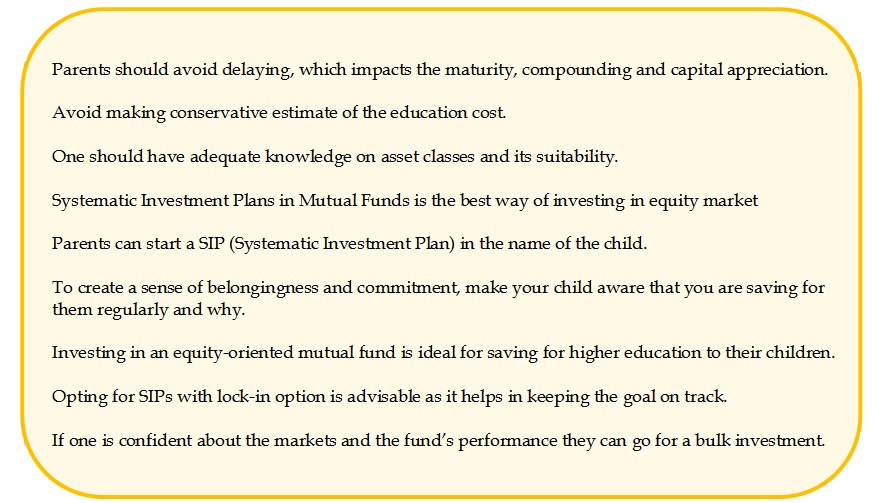 Education inflation
Education inflation
Every parent aspires to give a quality higher education to their children, when they grow up. What stumbles upon is the rise in cost of education. Over years, estimates show that the cost of primary and secondary education increases at an inflation rate of 12% and Higher education between 16%-20%, in India. Among the financial instruments, equities have a track record of delivering higher returns compared to other asset classes, in the long run. An equity oriented mutual fund would be suitable for this goal and there are schemes that have been designed for planning children’s future. They are named accordingly.
About SIP
Ideally parent can start a SIP (Systematic Investment Plan) in the name of the child. Systematic Investment Plans in mutual funds is the best way of investing in equity market, as they play in favor of value Investing in both bull and bear markets, with compounding and cost averaging, respectively. For someone who is new to this phrase, SIP is an investment method in which Investors choose to invest a fixed sum every month on a pre-selected date in a mutual fund scheme, and for a pre-defined period (which ideally should align with number of years to reach the goal). Since Investment happens every month, it eliminates the risk of timing the market. When the price of the selected mutual fund unit, technically called as Net Asset Value (NAV), goes down due to the drop in market value of portfolio, Investor buys more units. When the price (NAV) goes up, Investor buys lesser units, thereby achieving a better Average Purchase Price over the investment tenure. When the portfolio appreciates in the long term reflecting the broader markets and economy, as it did in the past, Compounding helps in delivering higher returns on all units accumulated.
About Children Gift Plans
There are few schemes dedicated to children, which parent could use as a meaningful gift for securing their kid’s financial future. They invest the corpus in equity oriented instruments, hence are subject to intermittent market volatility. If one is confident about the markets and the fund’s performance, he or she can go for a bulk investment, else simply choose the way of SIP. They come with ‘lock-in’ and ‘without lock-in’ options. Lock-in period is until the unit holder, here the child, attains 18 years of age or 3 years from allotment, whichever is later. We suggest parent to opt for the lock-in option as it helps in keeping the goal on track and avoids any deviation.
Other Investment Options:
As a matter of fact, we have schemes named ‘Children’, ‘Young citizens’, etc. primarily intended to plan for child’s future (education, marriage, etc.). But Parents who are planning for children’s education in India or abroad, can also go for other type of equity – oriented diversified schemes like a Balanced fund or a Multicap fund. If one were to plan for long-term goals, equity-oriented investments has the potential to deliver better returns, going by empirical data.
As advised earlier, If the risk appetite of a parent permits, one can even consider Midcap, Smallcap or thematic schemes, provided judicious allocation are made. We suggest to move them gradually into a balanced fund or fixed income scheme once they are closer to the goal attaining period.
Look Before You Leap
There are few mistakes which parents usually make while investing for their children’s education. First of all, majority of the parents make a delayed start in investing. A late beginning definitely impacts the maturity value, compounding effect on investments and capital appreciation. Parents can prepare themselves to meet the cost of their child’s higher education by setting aside a sum every month, start investing early and invest it regularly.
Secondly, parents often opt for a conservative estimate while calculating the future cost of education. Assumption of relevant inflationary rate prevailing in education sector is important. We suggest to include the cost of accommodation and food. Lack of information could be a reason for such estimates and some amount of enquires and search can help to make a refined plan.
Ideally, parents who are keen to send their children abroad for education should plan to cover the future cost of education suitably. What’s more, they should calculate the probable future cost involving food, accommodation and living expenses in the desired destination, keeping in mind the exchange rate/currency fluctuations (for example, a USD 10000 would cost Rs.6,00,000 if INR is at 60 and Rs.7,00,000 if INR is at 70)
Not having adequate knowledge about asset classes and its suitability is another common mistake parents make. For instance, one should know the facts like investing in equities for short-term is highly risky, but it is good for long-term. Saving through fixed income for long-term, yields less than inflation return post-tax.
Not having a dedicated investment plan for specific goals is another common slipup. It so happens, parents end up using retirement funds or old age corpus to fund children education, as mostly it coincides with the time of higher education.
There is a tendency among parents of keeping their children in isolation about the investments. But, at a certain age, it’s good to responsibly empower them with the investment information. This way, children will also understand the parent’s hard work and planning. It acts as a strong inspiration for them.

Posted: September 2018









Very informative